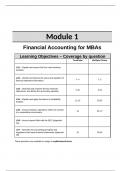Examen
Test Bank for Financial Accounting for MBAs 8th Edition By Easton (All Chapters) Latest 2024 A+
- Cours
- Établissement
- Book
Test Bank for Financial Accounting for MBAs 8th Edition By Easton (All Chapters) Latest 2024 A+ Test Bank for Financial Accounting for MBAs 8th Edition By Easton
[Montrer plus]




